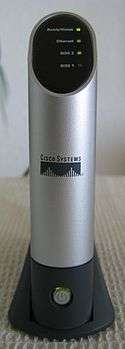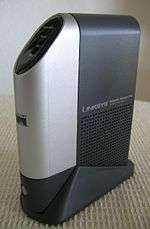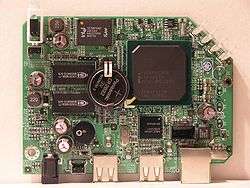NSLU2
The NSLU2 (Network Storage Link for USB 2.0 Disk Drives) is a network-attached storage (NAS) device made by Linksys introduced in 2004 and discontinued in 2008. It makes USB flash memory and hard disks accessible over a network using the SMB protocol (also known as Windows file sharing or CIFS). It was superseded mainly by the NAS200 (enclosure type storage link) and in another sense by the WRT600N and WRT300N/350N which both combine a Wi-Fi router with a storage link.
 An NSLU2 | |
| Manufacturer | Linksys |
|---|---|
| Type | NAS |
| Release date | June 15, 2004 |
| Lifespan | 2004–2008 |
| Operating system | Linux based |
| CPU | 266 MHz ARM Intel XScale IXP420 |
| Memory | 32 MB SDRAM, 8 MB flash |
| Storage | External hard drive/flash disk |
| Connectivity | USB, Network |
| Power | 5V DC Adapter |
| Dimensions | 2.1 x 9.1 x 13 cm |
| Mass | 0.2 kg |
The device runs a modified version of Linux and by default, formats hard disks with the ext3 filesystem, but a firmware upgrade from Linksys adds the ability to use NTFS and FAT32 formatted drives with the device for better Windows compatibility. The device has a web interface from which the various advanced features can be configured, including user and group permissions and networking options.
Hardware
The device has two USB 2.0 ports for connecting hard disks and uses an ARM-compatible Intel XScale IXP420 CPU. In models manufactured prior to around April 2006, Linksys had underclocked the processor to 133 MHz, though a simple hardware modification to remove this restriction is possible. Later models (circa. May 2006) are clocked at the rated speed of 266 MHz. The device includes 32 MB of SDRAM, and 8 MB of flash memory. It also has a 100 Mbit/s Ethernet network connection. The NSLU2 is fanless, making it completely silent.
User community
Stock, the device runs a customised version of Linux. Linksys was required to release their source code as per the terms of the GNU General Public License. Due to the availability of source code, the NSLU2's use of well-documented commodity components and its relatively low price, there are several community projects centered around it, including hardware modifications, alternative firmware images, and alternative operating systems with varying degrees of reconfiguration.
Hardware modifications

Unofficial hardware modifications include:
- Doubling the clock frequency on underclocked units.[1] As of summer 2006, the NSLU2 was sold without the "underclocking"
- Addition of a serial port
- Addition of a JTAG port
- Enabling extra USB ports
- Addition of extra memory
- NSLU2 units that have had their memory upgraded are commonly referred to as 'FatSlugs'[2]
- Devices have been successfully upgraded to 64 MB but not stable operation with 128 MB and 256 MB of RAM[3]
- The version with 256 MB RAM and 16 MB flash (twice the standard amount) has been nicknamed 'ObeseSlug'[4]
- Forced Power On[5]
- Adding an HD44780 controlled dot matrix display[6]
Alternative firmware

There are two main replacement firmware images available for the device: the first is Unslung which is based on the official Linksys firmware with some improvements and features added.[7] Optware packages are available to expand functionality. The other is SlugOS/BE (formerly OpenSlug), which is based on the OpenEmbedded framework.[8] SlugOS/BE allows users to re-flash the device with a minimal Linux system including an SSH server to allow remote access. Once installed, the operating system must be moved to an attached hard disk due to the lack of space available on the flash memory. Once this has been done, a wide range of additional packages are available to be installed from an Internet repository.
It is also possible to run OpenWrt,[9] Debian,[10] Gentoo,[11] FreeBSD,[12] NetBSD,[13] OpenBSD,[14] and Ubuntu[15][16] on the device.
The ability to run an unrestricted operating system on the device opens up a whole new range of uses. Some common uses are a web server, mail server, DAAP server (iTunes), XLink Kai, UPnP AV MediaServers, BitTorrent client, FreeSWITCH, asterisk PBX[17] and network router (with the attachment of a USB network interface/USB modem). German programmer Boris Pasternak developed the weather server program/server Meteohub as an inexpensive way to gather weather sensor data from personal weather stations ("PWS") and allow it to be posted on a number of online weather services including Weather Underground, Weatherbug, Citizens Weather Observation Program (CWOP), and many others.
An NSLU2 with Unslung firmware can be interfaced with a Topfield TF5800 personal video recorder (PVR) to allow an electronic programme guide (EPG) to be automatically downloaded from the Internet and transferred to the PVR.[18]
Problems
- As with most NASs, the device is not immediately compatible with Windows Vista or 7, as it runs an older version of Samba that uses an authentication mechanism that is disabled by default in later versions of Windows. Ways of enabling the older (and less secure) authentication are available.[19][20]
- Later builds of the system use more recent firmware than versions downloadable from the official websites. In the past, the UK website had more outdated firmware than the US website.
- The device with stock firmware had some compatibility issues with certain hard drives.
- The device will not power on automatically when it gets power from an external supply. This might be a problem in an environment where power failures are frequent. Automatic-power-on is possible only with one of several external or internal hardware or wiring modifications.[21]
Awards
The NSLU2 won the "Most Innovative in Networking" Reader Award in the Tom's Hardware 2004 Awards.
Similar Devices
References
- Overclocking (De-Underclocking) the NSLU2
- FatSlug
- Kernel Bug Tracker Bug 7760
- ObeseSlug
- NSLU2 ForcePowerAlwaysOn
- NSLU2 Add an LCD Display via the I2C
- The Unslung firmware
- The OpenSlug firmware
- OpenWrt NSLU2 Wiki page
- Debian on NSLU2
- Gentoo on the NSLU2
- FreeBSD on the NSLU2
- NetBSD on the NSLU2
- OpenBSD boots and runs on Linksys NSLU2
- ARM Port of Ubuntu
- Ubuntu NSLU2 User group
- Asterisk PBX on NSLU2
- About rt2mei, software to download EPG data from the Internet to a Topfield PVR
- Instructions for Using Windows Vista with a Network File Server (NAS)
- Windows 7 and NSLU2
- NSLU2 ForcePowerAlwaysOn
